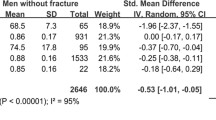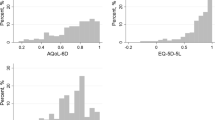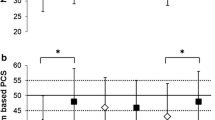Abstract
Summary
Little is known about the association between health-related quality of life (HRQOL) and osteoporosis in the absence of fracture, and how HRQOL may change over time. This study provides evidence of substantially reduced HRQOL in women and men with self-reported and/or BMD-confirmed osteoporosis, even in the absence of fragility fracture.
Introduction
Fragility fractures have a detrimental effect on the health-related quality of life (HRQOL) of those with osteoporosis. Less is known about the association between HRQOL and osteoporosis in the absence of fracture.
Methods
Canadian Multicentre Osteoporosis Study participants completed the SF-36, a detailed health questionnaire and measures of bone mineral density (BMD) at baseline and follow-up. We report the results of participants ≥ 50 years with 10-year follow-up. Self-reported osteoporosis at baseline and BMD-based osteoporosis at follow-up were ascertained. Multivariable linear regression models were developed for baseline SF-36 domains, component summaries, and change over time, adjusting for relevant baseline information.
Results
Baseline data were available for 5266 women and 2112 men. Women in the osteoporosis group had substantially lower SF-36 baseline scores, particularly in the physically oriented domains, than those without osteoporosis. A similar but attenuated pattern was evident for the men. After 10-year follow-up (2797 women and 1023 men), most domain scores dropped for women and men regardless of osteoporosis status, with the exception of mentally-oriented ones. In general, a fragility fracture was associated with lower SF-36 scores and larger declines over time.
Conclusions
This study provides evidence of substantially reduced HRQOL in women and men with self-reported and/or BMD-confirmed osteoporosis, even in the absence of fragility fracture. HRQOL should be thoroughly investigated even prior to fracture, to develop appropriate interventions for all stages of the disease.


Similar content being viewed by others
References
Adachi JD, Ioannidis G, Berger C, Joseph L, Papaioannou A, Pickard L et al (2001) The influence of osteoporotic fractures on health-related quality of life in community-dwelling men and women across Canada. Osteoporos Int 12:903–908
Silverman SL, Minshall ME, Shen W, Harper KD, Xie S (2001) The relationship of health-related quality of life to prevalent and incident vertebral fractures in postmenopausal women with osteoporosis: results from the multiple outcomes of Raloxifene Evaluation Study. Arthritis Rheum 44(11):2611–2619
Adachi JD, Ioannidis G, Pickard L, Berger C, Prior JC, Joseph L, Hanley DA, Olszynski WP, Murray TM, Anastassiades T, Hopman W, Brown JP, Kirkland S, Joyce C, Papaioannou A, Poliquin S, Tenenhouse A, Papadimitropoulos EA (2003) The association between osteoporotic fractures and health-related quality of life as measured by the health utilities index in the Canadian Multicentre Osteoporosis Study (CaMos). Osteoporos Int 14(11):895–904
Silverman SL, Piziak VK, Chen P, Misurski DA, Wagman RB (2005) Relationship of health related quality of life to prevalent and new or worsening back pain in postmenopausal women with osteoporosis. J Rheumatol 32(12):2405–2409
Salaffi F, Cimmino MA, Malavolta N, Carotti M, Di Matteo L, Scendoni P et al (2007) The burden of prevalent fractures on health-related quality of life in postmenopausal women with osteoporosis: the IMOF study. J Rheumatol 34(7):1551–1560
Hagino H, Nakamura T, Fujiwara S, Oeki M, Okano T, Teshima R (2009) Sequential change in quality of life for patients with incident clinical fractures: a prospective study. Osteoporos Int 20(5):695–702
Papaioannou A, Kennedy CC, Ioannidis G, Sawka A, Hopman WM, Pickard L et al (2009) The impact of incident fractures on health-related quality of life: 5 years of data from the Canadian multicentre osteoporosis study. Osteoporos Int 20(5):703–714
Lips P, van Schoor NM (2005) Quality of life in patients with osteoporosis. Osteoporos Int 16(5):447–455
Guillemin F, Martinez L, Calvert M, Cooper C, Ganiats T, Gitlin M, Horne R, Marciniak A, Pfeilschifter J, Shepherd S, Tosteson A, Wade S, Macarios D, Freemantle N (2013) Fear of falling, fracture history, and comorbidities are associated with health-related quality of life among European and US women with osteoporosis in a large international study. Osteoporos Int 24(12):3001–3010
Bianchi ML, Orsini MR, Saraifoger S, Ortolani S, Radaelli G, Betti S (2005) Quality of life in post-menopausal osteoporosis. Health Qual Life Outcomes 3:78
Yoh K, Tanaka K, Ishikawa A, Ishibashi T, Uchino Y, Sato Y, Tobinaga M, Hasegawa N, Kamae S, Yoshizawa M (2005) Health-related quality of life (HRQOL) in Japanese osteoporotic patients and its improvement by elcatonin treatment. J Bone Miner Metab 23(2):167–173
Munch S, Shapiro S (2006) The silent thief: osteoporosis and women’s health care across the life span. Health Soc Work 31(1):44–53
Martin AR, Sornay-Rendu E, Chandler JM, Duboeuf F, Girman CJ, Delmas PD (2002) The impact of osteoporosis on quality-of-life: the OFELY cohort. Bone 31(1):32–36
Sanfelix-Genoves J, Hurtado I, Sanfelix-Gimeno G, Reig-Molla B, Peiro S (2011) Impact of osteoporosis and vertebral fractures on quality-of-life. A population-based study in Valencia, Spain (the FRAVO study). Health Qual Life Outcomes 9:20
Dennison EM, Syddall HE, Statham C, Aihie SA, Cooper C (2006) Relationships between SF-36 health profile and bone mineral density: the Hertfordshire cohort study. Osteoporos Int 17(9):1435–1442
Wilson S, Sharp CA, Davie MW (2015) Health-related quality of life in women referred for bone density assessment: relationships with bone mineral density, fracture and co-morbidity. Quality of Life Res 24(5):1235–1243
Romagnoli E, Carnevale V, Nofroni I, D'Erasmo E, Paglia F, De Geronimo S et al (2004) Quality of life in ambulatory postmenopausal women: the impact of reduced bone mineral density and subclinical vertebral fractures. Osteoporos Int 15(12):975–980
Dhillon V, Hurst N, Hannan J, Nuki G (2005) Association of low general health status, measured prospectively by Euroqol EQ5D, with osteoporosis, independent of a history of prior fracture. Osteoporos Int 16(5):483–489
Li G, Thabane L, Papaioannou A, Ionnidis G, Levine MAH, Adachi JD (2017) An overview of osteoporosis and frailty in the elderly. BMC Musculoskelet Disord 18:46
Wilson S, Sharp CA, Davie MW (2012) Health-related quality of life in patients with osteoporosis in the absence of vertebral fracture: a systematic review. Osteoporos Int 23(12):2749–2768
Lydick E, Martin A, Yawn B (1996) Impact of fears on quality of life in patients with a silent disease: osteoporosis. Clin Ther 18(6):1307–1315
Johnson Wright L, Afari N, Zautra A (2009) The illness uncertainty concept: a review. Curr Pain Headache Rep 13(2):133–138
Frostholm L, Fink P, Christensen KS, Toft T, Oernboel E, Olesen F, Weinman J (2005) The patients’ illness perceptions and the use of primary health care. Psychosom Med 67(6):997–1005
Kreiger N, Tenenhouse A, Joseph L, MacKenzie T, Poliquin S, Brown J et al (1999) The Canadian Multicentre Osteoporosis Study (CaMos): background, rationale, methods. Can J Aging 18:376–387
Hopman W, Towhee T, Anastassiades T, Tenenhouse A, Poliquin S, Berger C et al (2000) Canadian normative data for the SF-36 health survey. Can Med Assoc J 163:265–271
Berger C, Goltzman D, Langsetmo L, Joseph L, Kreiger N, Tenenhouse A, Davison KS, Josse RG, Prior JC, Hanley DA, the CaMos Research Group (2010) Peak bone mass from longitudinal data: implications for the prevalence, pathophysiology, and diagnosis of osteoporosis. J Bone Miner Res 25(9):1948–1957
Charlson ME, Pompei P, Ales KL, MacKenzie CR (1987) A new method of classifying prognostic comorbidity in longitudinal studies: development and validation. J Chronic Dis 40:373–383
Richards JB, Papaioannou A, Adachi JD, Joseph L, Whitson HE, Prior JC, Goltzman D, Canadian Multicentre Osteoporosis Study Research Group (2007) Effect of selective serotonin reuptake inhibitors on risk of fracture. Arch Intern Med 167(2):188–194
Ware JE Jr, Snow KK, Kosinski M, Gandek B (1993) SF-36 health survey manual and interpretation guide. The Health Institute, New England Medical Center, Boston
Ware JE Jr, Kosinski M, Keller SD (1994) SF-36 physical and mental summary scales: a user’s manual. The Health Institute, New England Medical Center, Boston
Kingwell E, Prior JC, Ratner PA, Kennedy SM (2010) Direct-to-participant feedback and awareness of bone mineral density testing results in a population-based sample of mid-aged Canadians. Osteoporos Int 21(2):307–319
Ware JE Jr (2000) SF-36 health survey updated. Spine 25(24):3130–3139
Garratt A, Schmidt L, Mackintosh A, Fitzpatrick R (2002) Quality of life measurement: bibliographic study of patient assessed health outcome measures. BMJ 324(7351):1417
Hopman WM, Harrison MB, Coo H, Friedberg E, Buchanan M, VanDenKerkhof EG (2009) Associations between chronic disease, age and physical and mental health status. Chronic Dis Can 29(3):108–116
Bayliss EA, Bayliss MS, Ware JE Jr, Steiner JF (2004) Predicting declines in physical function in persons with multiple chronic medical conditions: what we can learn from the medical problem list. Health Qual Life Outcomes 2:47
Hopman WM, Berger C, Joseph L, Zhou W, Prior JC, Towheed T et al (2014) Prospectively measured 10-year changes in health-related quality of life and comparison with cross-sectional estimates in a population-based cohort of adult women and men. Quality Life Res 23(10):2707–2721
Madureira MM, Ciconelli RM, Pereira RM (2012) Quality of life measurements in patients with osteoporosis and fracture. Clinics 67(11):1315–1320
Schwartz CE, Bode R, Repucci N, Becker J, Sprangers MA, Fayers PM (2006) The clinical significance of adaptation to changing health: a meta-analysis of response shift. Quality Life Res 15(9):1533–1550
Lix LM, Acan Osman B, Adachi JD, Towheed T, Hopman W, Davison KS, Leslie WD (2012) Measurement equivalence of the SF-36 in the Canadian Multicentre Osteoporosis Study. Health Qual Life Outcomes 10:29
Lix LM, Wu X, Hopman W, Mayo N, Sajobi TT, Liu J, Prior JC, Papaioannou A, Josse RG, Towheed TE, Davison KS, Sawatzky R (2016) Differential item functioning in the SF-36 physical functioning and mental health sub-scales: a population-based investigation in the Canadian Multicentre Osteoporosis Study. PLoS One 11(3):e0151519
Acknowledgements
The Canadian Multicentre Osteoporosis Study (CaMos) is currently funded by the Canadian Institutes of Health Research (CIHR) and Amgen Canada Incorporated. The CaMos Research Group: David Goltzman (co-principal investigator, McGill University), Nancy Kreiger (co-principal investigator, University of Toronto), Alan Tenenhouse (principal investigator emeritus, Toronto). McGill University, Montreal, Quebec: Elham Rahme (biostatistician), J. Brent Richards (investigator), Suzanne N. Morin (investigator); Data Analysis Centre: Claudie Berger (study statistician). Memorial University, St. John’s Newfoundland: Carol Joyce (director), Christopher S. Kovacs (co-director). Dalhousie University, Halifax, Nova Scotia: Susan Kirkland, Stephanie M. Kaiser (co-directors). Laval University, Quebec City, Quebec: Jacques P. Brown (director), Louis Bessette (co-director), GRMO. Queen’s University, Kingston, Ontario: Tassos P. Anastassiades (director), Tanveer Towheed (co-director), and Wilma M. Hopman (investigator). University of Toronto, Toronto, Ontario: Angela M. Cheung (director), Robert G. Josse (co-director), and Andy Kin On Wong (co-director). McMaster University, Hamilton, Ontario: Jonathan D. Adachi (director), Alexandra Papaioannou (co-director). University of Saskatchewan, Saskatoon, Saskatchewan: Wojciech P. Olszynski (director), K. Shawn Davison (co-director). University of Calgary, Calgary, Alberta: David A. Hanley (director), Steven K. Boyd (co-director). University of British Columbia, Vancouver, British Columbia: Jerilynn C. Prior (director), Shirin Kalyan (co-director), Brian Lentle (investigator/radiologist), Millan S. Patel (investigator). University of Alberta, Edmonton, Alberta: Stuart D. Jackson (medical physicist). University of Manitoba, Winnipeg, Manitoba: William D. Leslie (investigator/nuclear medicine physician).
Author information
Authors and Affiliations
Consortia
Corresponding author
Ethics declarations
Conflicts of interest
Wilma M. Hopman, Claudie Berger, Lawrence Joseph, Tanveer Towheed, Tassos Anastassiades, David A. Hanley, Jerilynn Prior, and David Goltzman declare that they have no conflict of interest.
Suzanne N Morin declares that she has conflicts of interest but that they do not pertain to the current paper. She receives research grants paid to the Research Institute of the McGill University Health Centre from Merck and Amgen.
Jonathan D. Adachi declares that he has conflicts of interest but he does not believe that they pertain to the current paper. He is on the Amgen speaker’s bureau, conducts clinical trials with them and is a scientific advisor. In addition he is a past president of Osteoporosis Canada and sits on the board of directors, and is a scientific advisor for the International Osteoporosis Foundation.
Additional information
Publisher’s note
Springer Nature remains neutral with regard to jurisdictional claims in published maps and institutional affiliations.
Rights and permissions
About this article
Cite this article
Hopman, W., Berger, C., Joseph, L. et al. Longitudinal assessment of health-related quality of life in osteoporosis: data from the population-based Canadian Multicentre Osteoporosis Study. Osteoporos Int 30, 1635–1644 (2019). https://doi.org/10.1007/s00198-019-05000-y
Received:
Accepted:
Published:
Issue Date:
DOI: https://doi.org/10.1007/s00198-019-05000-y




